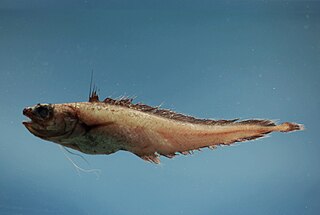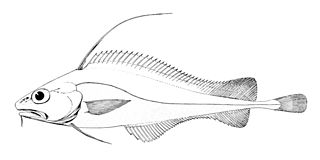
Cod is the common name for the demersal fish genus Gadus, belonging to the family Gadidae. Cod is also used as part of the common name for a number of other fish species, and one species that belongs to genus Gadus is commonly not called cod.

Ziziphus jujuba, commonly called jujube, red date, Chinese date, Chinese jujube is a species in the genus of Ziziphus, in the buckthorn family (Rhamnaceae).
In biology, a monotypic taxon is a taxonomic group (taxon) that contains only one immediately subordinate taxon.

The Tortricidae are a family of moths, commonly known as tortrix moths or leafroller moths, in the order Lepidoptera. This large family has over 11,000 species described, and is the sole member of the superfamily Tortricoidea, although the genus Heliocosma is sometimes placed within this superfamily. Many of these are economically important pests. Olethreutidae is a junior synonym. The typical resting posture is with the wings folded back, producing a rather rounded profile.

The codling moth is a member of the Lepidopteran family Tortricidae. They are major pests to agricultural crops, mainly fruits such as apples and pears. Because the larvae are not able to feed on leaves, they are highly dependent on fruits as a food source and thus have a significant impact on crops. The caterpillars bore into fruit and stop it from growing, which leads to premature ripening. Various means of control, including chemical, biological, and preventive, have been implemented. This moth has a widespread distribution, being found on six continents. Adaptive behavior such as diapause and multiple generations per breeding season have allowed this moth to persist even during years of bad climatic conditions.

Myoporum is a genus of flowering plants in the figwort family, Scrophulariaceae. There are 30 species in the genus, eighteen of which are endemic to Australia although others are endemic to Pacific Islands, including New Zealand, and one is endemic to two Indian Ocean islands. They are shrubs or small trees with leaves that are arranged alternately and have white, occasionally pink flowers and a fruit that is a drupe.

Xanthone is an organic compound with the molecular formula C13H8O2. In 1939, xanthone was introduced as an insecticide and it currently finds uses as ovicide for codling moth eggs and as a larvicide. Xanthone is also used in the preparation of xanthydrol, which is used in the determination of urea levels in the blood. It can also be used as a photocatalyst.

Heterodon platirhinos, commonly known as the eastern hog-nosed snake, spreading adder, or deaf adder, is a colubrid species endemic to North America. No subspecies are currently recognized.

The northern bastard codling is a morid cod of the genus Pseudophycis, found around southern Australia including Tasmania, and New Zealand, from the surface to 220 m. Its length is between 15 and 25 cm.

The southern bastard codling or bearded red cod is a morid cod of the genus Pseudophycis, found around southern Australia including Tasmania, and New Zealand, from the surface to 300 m. Its length is up to 63 cm.
Abergasilus amplexus is a species of parasitic copepod endemic to euryhaline habitats in New Zealand. It is the only known species in the genus Abergasilus.

Comandra is a monotypic genus containing the single species Comandra umbellata. Its common names include bastard toadflax, umbellate bastard toadflax, and common comandra. The plant has a disjunct distribution; its four subspecies occur in North America and the Mediterranean.

Gadella is a genus of morid cod. The species in this genus are characterised by the absence of a chin barbell, an anterior dorsal fin with 7-11 rays, a long based anal fin which has a straight profile, the outermost rays of the pelvic fin are filamentous and extend a small distance beyond the membrane. They do not have a photophore. The Gadella codlings are found around the tropical and subtropical seas around the world on the outer continental shelf to the mid continental slope. They are of no interest to fisheries.

Thaumatotibia (Cryptophlebia) leucotreta, commonly known as the false codling moth, orange moth, citrus codling moth or orange codling moth, is a moth in the family Tortricidae under the order of Lepidoptera. Larvae of the moth feed on a wide range of crops from cotton and macadamia nuts to Citrus species. The larvae have a less selective diet than the codling moth, which feeds primarily on temperate fruit crops.

Petter's big-footed mouse, is a Madagascan rodent in the genus Macrotarsomys. With a head and body length of 150 mm (5.9 in) and body mass of 105 g (3.7 oz), It is the largest species of its genus. The upperparts are brown, darkest in the middle of the back, and the underparts are white to yellowish. The animal has long whiskers, short forelimbs, and long hindfeet. The tail ends in a prominent tuft of long, light hairs. The skull is robust and the molars are low-crowned and cuspidate.
The Tasmanian codling is a species of morid cod only known from the waters around Tasmania and the Australian states of Western Australia and Victoria. It is found in relatively shallow waters at depths from 8 to 12 m. This species grows to 26 cm (10 in) in total length. This is the only known species in its genus.

Laemonema is a genus of morid cods.

Lepidion is a genus of morid cods.
Notophycis is a genus of morid cods.

Urophycis is a genus of phycid hakes.

















